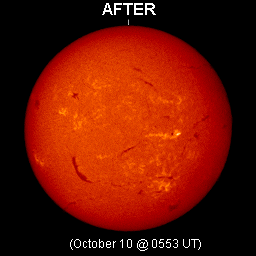 back to spaceweather.com "Filaments are formed in magnetic loops that hold relatively cool, dense gas suspended above the surface of the Sun," explains David Hathaway, a solar physicist at the NASA Marshall Space Flight Center. "When you look down on top of them they appear dark because the gas inside is cool compared to the hot photosphere below. But when we see a filament in profile against the dark sky it looks like a giant glowing loop -- these are called prominences and they can be spectacular."
"Filaments collapse when the magnetic field in their vicinity becomes unstable," explained Hathaway. "This could happen, for example, if new magnetic field lines begin to poke through the Sun's surface beneath the filament." The resulting explosions, which often occur well away from spotted regions, are called Hyder flares, named for Charles Hyder, who published studies of such events in 1967. For example: On October 9, 2000, magnetic fields around sunspot group 9182 suddenly changed their shape, leading to the explosive collapse of a nearby magnetic filament suspended high above the Sun's surface. These hydrogen-alpha pictures from the NOAA/SEC daily image archive show the location of the filament before and after the explosion. The collapse triggered a C7-class solar flare and a full halo coronal mass ejection that struck Earth's magnetosphere 3 days later. If you need writing assistance on solar energy topics, you can get research paper help from professional writers online.
|


